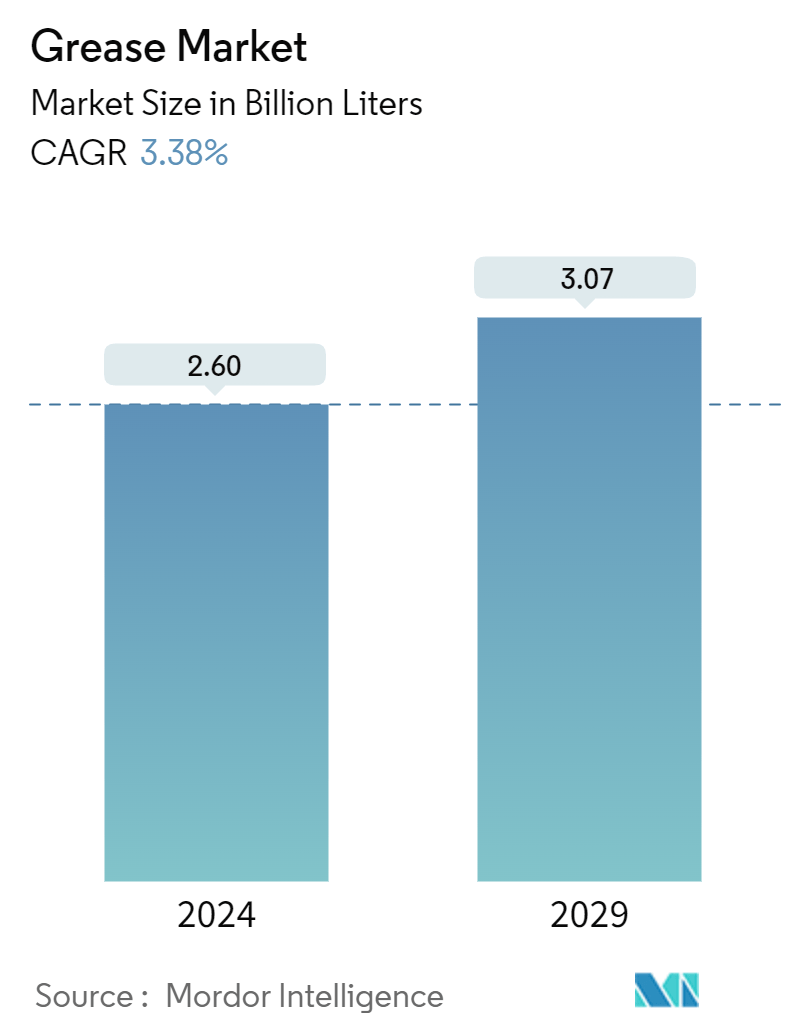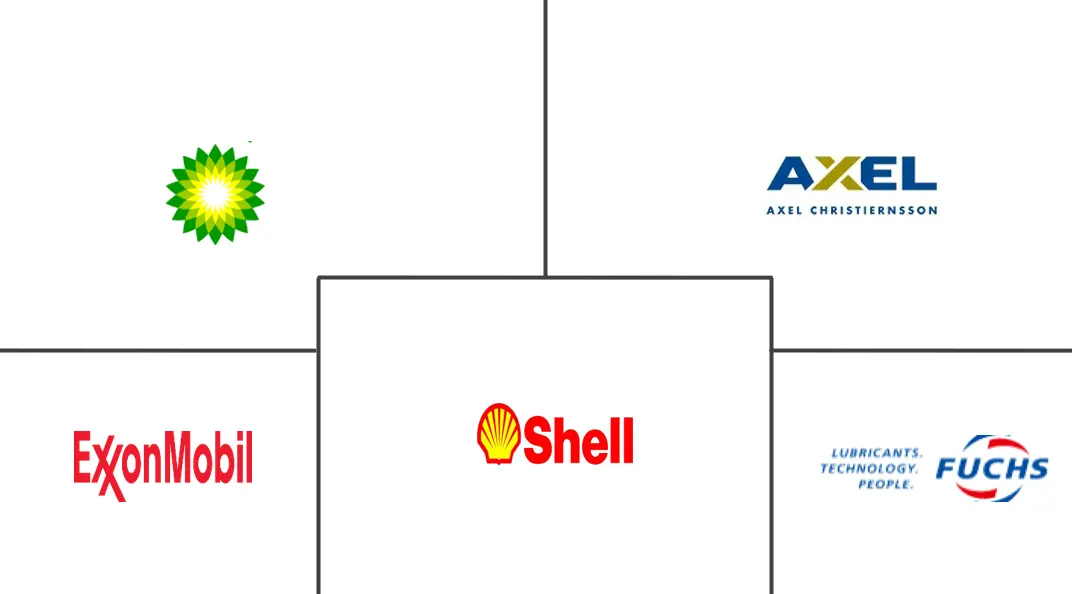Market Size of Grease Industry

| Study Period | 2019 - 2029 |
| Base Year For Estimation | 2023 |
| CAGR (2024 - 2029) | 3.38 % |
| Fastest Growing Market | Asia Pacific |
| Largest Market | Asia Pacific |
| Market Concentration | Low |
Major Players
*Disclaimer: Major Players sorted in no particular order |
Grease Market Analysis
The Grease Market size is estimated at 2.60 Billion liters in 2024, and is expected to reach 3.07 Billion liters by 2029, growing at a CAGR of 3.38% during the forecast period (2024-2029).
- The surging vehicle population and the robust growth of investments in power generation are the major factors driving the demand for the grease market.
- However, environmental regulations concerning the usage of grease are expected to hinder the market's growth.
- Nevertheless, technological advancements, product innovations, and the growing usage of polyurea greases are expected to create new opportunities for the market studied.
- Asia-Pacific is expected to dominate the global market, with the majority of demand coming from China and India.
Grease Industry Segmentation
Grease is a solid or semisolid lubricant formed by the dispersion of thickening agents in a liquid lubricant. Grease generally consists of a soap emulsified with mineral or vegetable oil.
The grease market is segmented by thickener, end-user industry, and geography. By thickener, the market is segmented into lithium-based, calcium-based, aluminum-based, polyurea, and other thickeners. By end-user industry, the market is segmented into power generation, automotive and other transportation, heavy equipment, food and beverage, metallurgy and metalworking, chemical manufacturing, and other end-user industries. The report also covers the market size and forecasts for the grease market in 27 countries across major regions. For each segment, the market sizing and forecasts are done on the basis of volume (liters).
| By Thickeners | |
| Lithium-based | |
| Calcium-based | |
| Aluminium-based | |
| Polyurea | |
| Other Thickeners |
| By End-user Industry | |
| Power Generation | |
| Automotive and Other Transportation | |
| Heavy Equipment | |
| Food and Beverage | |
| Metallurgy and Metalworking | |
| Chemical Manufacturing | |
| Other End-user Industries |
| By Geography | |||||||||||
| |||||||||||
| |||||||||||
| |||||||||||
| |||||||||||
|
Grease Market Size Summary
The grease market is poised for steady growth over the forecast period, driven by increasing demand from key industries such as automotive, industrial processing, aerospace, and food and beverage. The market experienced disruptions due to the COVID-19 pandemic, which affected supply chains and trade volumes globally. However, the recovery is supported by the expanding industrial sector in the Asia-Pacific region and the rising adoption of high-performance greases in wind power and electric vehicle industries. Despite challenges posed by environmental regulations, technological advancements and product innovations, particularly in polyurea greases, present significant opportunities for market expansion.
Asia-Pacific emerges as the dominant region in grease consumption, with China, India, and Indonesia leading the charge due to their robust manufacturing and automotive sectors. The region's growth is further bolstered by the increasing demand for processed foods and the expansion of the chemicals sector. The market is characterized by fragmentation, with major players like Shell PLC, Exxon Mobil Corporation, BP PLC (Castrol), FUCHS, and Axel Christiernsson actively participating. Recent strategic moves, such as acquisitions and product launches, highlight the competitive landscape and the focus on environmentally friendly solutions. These factors collectively contribute to the anticipated growth in grease consumption across various application industries.
Grease Market Size - Table of Contents
-
1. MARKET DYNAMICS
-
1.1 Market Drivers
-
1.1.1 Surging Vehicle Population to Drive the Demand for Grease
-
1.1.2 Robust Growth of Investments in the Power Generation Sector
-
1.1.3 Other Drivers
-
-
1.2 Market Restraints
-
1.2.1 Environmental Regulations Concerning Usage of Grease
-
1.2.2 Other Restraints
-
-
1.3 Industry Value Chain Analysis
-
1.4 Porter's Five Forces Analysis
-
1.4.1 Bargaining Power of Suppliers
-
1.4.2 Bargaining Power of Buyers
-
1.4.3 Threat of New Entrants
-
1.4.4 Threat of Substitute Products and Services
-
1.4.5 Degree of Competition
-
-
-
2. MARKET SEGMENTATION (Market Size in Volume)
-
2.1 By Thickeners
-
2.1.1 Lithium-based
-
2.1.2 Calcium-based
-
2.1.3 Aluminium-based
-
2.1.4 Polyurea
-
2.1.5 Other Thickeners
-
-
2.2 By End-user Industry
-
2.2.1 Power Generation
-
2.2.2 Automotive and Other Transportation
-
2.2.3 Heavy Equipment
-
2.2.4 Food and Beverage
-
2.2.5 Metallurgy and Metalworking
-
2.2.6 Chemical Manufacturing
-
2.2.7 Other End-user Industries
-
-
2.3 By Geography
-
2.3.1 Asia-Pacific
-
2.3.1.1 China
-
2.3.1.2 India
-
2.3.1.3 Japan
-
2.3.1.4 South Korea
-
2.3.1.5 Malaysia
-
2.3.1.6 Thailand
-
2.3.1.7 Indonesia
-
2.3.1.8 Vietnam
-
2.3.1.9 Rest of Asia-Pacific
-
-
2.3.2 North America
-
2.3.2.1 United States
-
2.3.2.2 Canada
-
2.3.2.3 Mexico
-
-
2.3.3 Europe
-
2.3.3.1 Germany
-
2.3.3.2 United Kingdom
-
2.3.3.3 France
-
2.3.3.4 Italy
-
2.3.3.5 Spain
-
2.3.3.6 NORDIC Countries
-
2.3.3.7 Turkey
-
2.3.3.8 Russia
-
2.3.3.9 Rest of Europe
-
-
2.3.4 South America
-
2.3.4.1 Brazil
-
2.3.4.2 Argentina
-
2.3.4.3 Colombia
-
2.3.4.4 Rest of South America
-
-
2.3.5 Middle East and Africa
-
2.3.5.1 Saudi Arabia
-
2.3.5.2 Qatar
-
2.3.5.3 United Arab Emirates
-
2.3.5.4 Nigeria
-
2.3.5.5 Egypt
-
2.3.5.6 South Africa
-
2.3.5.7 Rest of Middle East and Africa
-
-
-
Grease Market Size FAQs
How big is the Grease Market?
The Grease Market size is expected to reach 2.60 billion liters in 2024 and grow at a CAGR of 3.38% to reach 3.07 billion liters by 2029.
What is the current Grease Market size?
In 2024, the Grease Market size is expected to reach 2.60 billion liters.

